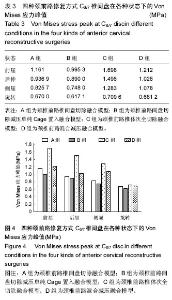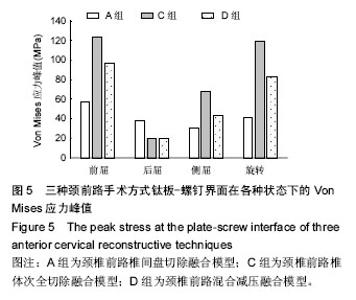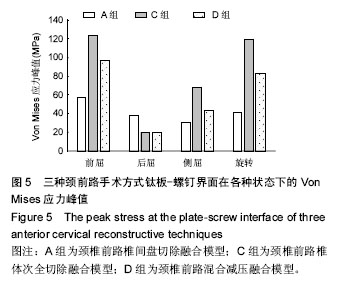Chinese Journal of Tissue Engineering Research ›› 2016, Vol. 20 ›› Issue (44): 6612-6619.doi: 10.3969/j.issn.2095-4344.2016.44.011
Previous Articles Next Articles
Biomechanics characteristics of four anterior cervical reconstructive techniques in the surgical management of multilevel cervical spondylotic myelopathy: a finite element model study
Li Zhong-hai, Lin Bin, Tang Jia-guang, Ren Dong-feng, Li Li, Wu Wen-wen, Hou Shu-xun
- Department of Orthopedics, First Affiliated Hospital of Chinese PLA General Hospital, Research Center of Orthopedic Implanted Equipment Engineering, Beijing 100048, China
-
Revised:2016-08-12Online:2016-10-28Published:2016-10-28 -
About author:Li Zhong-hai, M.D., Attending physician, Department of Orthopedics, First Affiliated Hospital of Chinese PLA General Hospital, Research Center of Orthopaedic Implanted Equipment Engineering, Beijing 100048, China -
Supported by:the Postdoctoral Science Foundation of China, No. 2015T81101; the Natural Science Foundation of Beijing, No. 7152144
CLC Number:
Cite this article
Li Zhong-hai, Lin Bin, Tang Jia-guang, Ren Dong-feng, Li Li, Wu Wen-wen, Hou Shu-xun. Biomechanics characteristics of four anterior cervical reconstructive techniques in the surgical management of multilevel cervical spondylotic myelopathy: a finite element model study[J]. Chinese Journal of Tissue Engineering Research, 2016, 20(44): 6612-6619.
share this article
| [1] Zhu B, Xu Y, Liu X, et al. Anterior approach versus posterior approach for the treatment of multilevel cervical spondylotic myelopathy: a systemic review and meta-analysis. Eur Spine J. 2013;22(7): 1583-1593. [2] Luo J, Cao K, Huang S, et al. Comparison of anterior approach versus posterior approach for the treatment of multilevel cervical spondylotic myelopathy. Eur Spine J. 2015;24(8):1621-1630. [3] 袁文,徐盛明,王新伟,等.前路分节段减压植骨融合术治疗多节段颈椎病的疗效分析[J]中国脊柱脊髓杂志, 2006, 16(2): 95-98. [4] Li Z, Huang J, Zhang Z, et al. A Comparison of Multilevel Anterior Cervical Discectomy and Corpectomy in Patients with 4-level Cervical Spondylotic Myelopathy: A Minimum 2-year Follow-up Study. J Spinal Disord Tech. 2016. [Epub ahead of print] [5] Li Z, Guo Z, Hou S, et al. Segmental anterior cervical corpectomy and fusion with preservation of middle vertebrae in the surgical management of 4-level cervical spondylotic myelopathy. Eur Spine J. 2014; 23(7):1472-1479. [6] 王良意,周杰,曹前来,等. 颈前路椎体次全切除联合椎间隙减压融合内固定术治疗多节段颈椎病[J]. 中国脊柱脊髓杂志, 2013, 23(12):1092-1096. [7] Yue WM,Brodner W,Hi ghland TR.Long-term results after anterior cervical discectomy and fusion with anterior plating:a 5 to 11-year radiologic and clinical follow-up study. Spine. 2005; 30(19):2138-2144. [8] Mobbs RJ, Rao P, Chandran NK. Anterior cervical discectomy and fusion: analysis of surgical outcome with and without plating. J Clin Neurosci. 2007; 14: 639-642. [9] Liu Y, Hou Y, Yang L, et al. Comparison of 3 reconstructive techniques in the surgical management of multilevel cervical spondylotic myelopathy. Spine. 2012; 37:E1450-1458. [10] Fountas KN, Kapsalaki EZ, Nikolakakos LG, et al. Anterior cervical discectomy and fusion associated complications. Spine. 2007;32:2310-2317. [11] Lowery GL, McDonough RF. The significance of hardware failure in anterior cervical plate fixation. Patients with 2- to 7-year follow-up. Spine,1998, 23:181-186; discussion 186-187. [12] Yue WM, Brodner W, Highland TR. Persistent swallowing and voice problems after anterior cervical discectomy and fusion with allograft and plating: a 5- to 11-year follow-up study. Eur Spine J. 2005;14: 677-682. [13] Park JB, Cho YS, Riew KD. Development of adjacent-level ossi?cation in patients with an anterior cervical plate. J Bone Joint Surg Am. 2005;87:558-563. [14] 李忠海,侯树勋,李利,等.颈椎融合与非融合后相邻节段生物力学改变:2次手术率的Meta分析[J].中国组织工程研究, 2015,19(4): 642-647. [15] Scholz M, Schnake KJ, Pingel A, et al. A new zero-profile implant for stand-alone anterior cervical interbody fusion. Clin Orthop Relat Res. 2011;469: 666-673. [16] Njoku I Jr, Alimi M, Leng LZ, et al. Anterior cervical discectomy and fusion with a zero-profile integrated plate and spacer device: a clinical and radiological study: Clinical article. J Neurosurg Spine. 2014;21(4): 529-537. [17] Scholz M, Schleicher P, Pabst S, et al. A zero-profile anchored spacer in multilevel cervical anterior interbody fusion: biomechanical comparison to established fixation techniques. Spine. 2015;40(7): E375-380. [18] Panjabi MM, Crisco JJ, Vasavada A, et al. Mechanical properties of the human cervical spine as shown by three-dimensional load-displacement curves. Spine. 2001;26(24):2692-2700. [19] Zhang QH, Teo EC, Ng HW, et al. Finite element analysis of moment-rotation relationships for human cervical spine. J Biomech. 2006;39(1):189-193. [20] Li Y, Lewis G. Influence of surgical treatment for disc degeneration disease at C5-C6 on changes in some biomechanical parameters of the cervical spine. Med Eng Phys. 2010;32(6):595-603. [21] 邹德威,谭荣,马华松,等.颈椎前路减压植骨融合不同术式长期随访结果比较[J].中国脊柱脊髓杂志, 2005, 15(1):69-72. [22] 唐步顺, 颜程, 胡汉祥,等. Smith-Robinson技术联合保留椎体后壁的椎体次全切除术治疗多节段颈椎病[J]. 中国脊柱脊髓杂志, 2015, 25(4):311-316. [23] Helgeson MD, Albert TJ. Surgery for failed cervical spine reconstruction. Spine. 2012;37(5):E323-327. [24] Fourney DR, Skelly AC, DeVine JG. Treatment of cervical adjacent segment pathology: a systematic review. Spine. 2012;37(22 Suppl):S113-122. [25] Chang UK, Kim DH, Lee MC, et al. Changes in adjacent-level disc pressure and facet joint force after cervical arthroplasty compared with cervical discectomy and fusion. J Neurosurg Spine. 2007;7:33-39. [26] Park DH, Ramakrishnan P, Cho TH, et al. Effect of lower two-level anterior cervical fusion on the superior adjacent level. J Neurosurg Spine. 2007;7(3):336-340. [27] Yang JY, Song HS, Lee M, et al. Adjacent level ossification development after anterior cervical fusion without plate fixation. Spine. 2009;34(1):30-33. [28] Koller H, Reynolds J, Zenner J, et al. Mid- to long-term outcome of instrumented anterior cervical fusion for subaxial injuries. Eur Spine J. 2009;18(5):630-653. [29] Goffin J, van Loon J, Van Calenbergh F, et al. Long-term results after anterior cervical fusion and osteosynthetic stabilization for fractures and/or dislocations of the cervical spine. J Spinal Disord. 1995;8(6):500-508; discussion 499. [30] Zhang Y, Quan Z, Zhao Z, et al. Evaluation of anterior cervical reconstruction with titanium mesh cages versus nano-hydroxyapatite/polyamide66 cages after 1- or 2-level corpectomy for multilevel cervicalspondylotic myelopathy: a retrospective study of 117 patients. PLoS One. 2014;9(5):e96265. [31] Shamji MF, Massicotte EM, Traynelis VC, et al.Comparison of anterior surgical options for the treatment of multilevel cervical spondylotic myelopathy: a systematic review. Spine (Phila Pa 1976). 2013; 38(22 Suppl 1):S195-209. [32] Liu Y, Qi M, Chen H, et al. Comparative analysis of complications of different reconstructive techniques following anterior decompression for multilevel cervical spondylotic myelopathy. Eur Spine J. 2012;21(12): 2428-2435. [33] Wei-bing X, Wun-Jer S, Gang L, et al. Reconstructive techniques study after anterior decompression of multilevel cervical spondylotic myelopathy. J Spinal Disord Tech. 2009;22(7):511-515. [34] Chen Z, Liu B, Dong J, et al. A Comparison of the Anterior Approach and the Posterior Approach in Treating Multilevel Cervical Myelopathy: A Meta-Analysis. Clin Spine Surg. 2016. [Epub ahead of print] [35] Ren H, Liu F, Yu D, et al.Patterns of Neurological Recovery After Anterior Decompression With Fusion and Posterior Decompression With Laminoplasty for the Treatment of Multilevel Cervical Spondylotic Myelopathy. Clin Spine Surg. 2016. [Epub ahead of print] [36] Xu L, Kong P, Xu ZW. [Anterior corpectomy decompression and titanium mesh bone iraft fusion combined with titanium nate fixation for the treatment of the multilevel cervical spondylotic myelopathy]. Zhongguo Gu Shang. 2016;29(3):211-215. Chinese. |
| [1] | Shi Bin, An Jing, Chen Long-gang, Zhang Nan, Tian Ye . Influencing factors for pain after total knee arthroplasty [J]. Chinese Journal of Tissue Engineering Research, 2017, 21(7): 993-997. |
| [2] | Wang Xian-xun. Impact of local compression cryotherapy combined with continuous passive motion on the early functional recovery after total knee arthroplasty [J]. Chinese Journal of Tissue Engineering Research, 2017, 21(7): 998-1003. |
| [3] | Yuan Wei, Zhao Hui, Ding Zhe-ru, Wu Yu-li, Wu Hai-shan, Qian Qi-rong. Association between psychological resilience and acute mental disorders after total knee arthroplasty [J]. Chinese Journal of Tissue Engineering Research, 2017, 21(7): 1015-1019. |
| [4] | Chen Qun-qun, Qiao Rong-qin, Duan Rui-qi, Hu Nian-hong, Li Zhao, Shao Min. Acu-Loc®2 volar distal radius bone plate system for repairing type C fracture of distal radius [J]. Chinese Journal of Tissue Engineering Research, 2017, 21(7): 1025-1030. |
| [5] | Huang Xiang-wang, Liu Hong-zhe. A new low elastic modulus of beta titanium alloy Ti2448 spinal pedicle screw fixation affects thoracic stability: biomechanical analysis [J]. Chinese Journal of Tissue Engineering Research, 2017, 21(7): 1031-1035. |
| [6] | Xie Qiang. Three-dimensional finite element model for biomechanical analysis of stress in knee inversion and external rotation after posterior cruciate ligament rupture [J]. Chinese Journal of Tissue Engineering Research, 2017, 21(7): 1036-1040. |
| [7] | He Ze-dong, Zhao Jing, Chen Liang-yu, Li Ke, Weng Jie. Multilevel finite element analysis on the biological tribology damage of water on bone tissue [J]. Chinese Journal of Tissue Engineering Research, 2017, 21(7): 1041-1045. |
| [8] | Jiang Zi-wei, Huang Feng, Cheng Si-yuan, Zheng Xiao-hui, Sun Shi-dong, Zhao Jing-tao, Cong Hai-chen,Sun Han-qiao, Dong Hang. Design and finite element analysis of digital splint [J]. Chinese Journal of Tissue Engineering Research, 2017, 21(7): 1052-1056. |
| [9] | Wang Fei, Liu Zhi-bin, Tao Hui-ren, Zhang Jian-hua, Li Chang-hong, Cao Qiang, Zheng Jun, Liu Yan-xiong, Qu Xiao-peng. Clinical efficacy of preoperative osteotomy designs using paper-cut technology versus photoshop software for ankylosing spondylitis with kyphosis [J]. Chinese Journal of Tissue Engineering Research, 2017, 21(7): 1057-1063. |
| [10] | Li Hui, Ma Jun-yi, Ma Yuan, Zhu Xu . Establishment of a three-dimensional finite element model of ankylosing spondylitis kyphosis [J]. Chinese Journal of Tissue Engineering Research, 2017, 21(7): 1069-1073. |
| [11] | Ling Guan-han, Ou Zhi-xue, Yao Lan, Wen Li-chun, Wang Guo-xiang, Lin Heng-feng. Establishment of simulating three-dimensional model of China-Japan Friendship Hospital Classification for L type osteonecrosis of the femoral head [J]. Chinese Journal of Tissue Engineering Research, 2017, 21(7): 1074-1079. |
| [12] | Fu Wei-min, Wang Ben-jie. Assessing the degree of necrotic femoral head, and association of blood supply with pathlogical changes: study protocol for a diagnostic animal trial [J]. Chinese Journal of Tissue Engineering Research, 2017, 21(7): 1086-1091. |
| [13] | Zhang Wen-qiang, Ding Qian, Zhang Na. Associations between alpha angle and herniation pit on oblique axial magnetic resonance imaging in asymptomatic hip joints of adults [J]. Chinese Journal of Tissue Engineering Research, 2017, 21(7): 1098-1103. |
| [14] | Sun Xiao-xin1, Zhou Wei2, Zuo Shu-ping3, Liu Hao1, Song Jing-feng1, Liang Chun-yu1. Morphological characteristics for the magnetic resonance imaging assessment of discoid lateral meniscal tears in children [J]. Chinese Journal of Tissue Engineering Research, 2017, 21(7): 1104-1109. |
| [15] | Lin Han-wen, Wen Jun-mao, Huang Chao-yuan, Zhou Chi, Tang Hong-yu. Correlation between the changes in lower limb power line and pain area in the knee osteoarthritis patients: imaging evaluation [J]. Chinese Journal of Tissue Engineering Research, 2017, 21(7): 1110-1114. |
| Viewed | ||||||
|
Full text |
|
|||||
|
Abstract |
|
|||||





